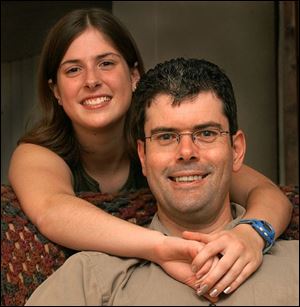
It may take a village, but more inhabitants are single fathers
6/15/2003
Everett DuPree is blocked by his son Josh, 13, on his way to the basket during a friendly game of basketball while Jacob, 10, rear left, and Tony, 17, take in the action. Mr. DuPree, of Ottawa Lake, Mich., said he didn't hesitate to become a single father in 1996. Tony now lives with his ex-wife, who also shares decision-making duties for the other children.
Frank Bernieri remembers his first major test as a single father: Throwing an all-day birthday party for his third-grader.
He invited a half-dozen of her friends over that morning, cooked them pancakes, and then expected them to entertain themselves - just like he and his friends would have as kids.
The girls soon were banging on the table, yelling, “We want to have fun!” Then one girl began crying and locked herself in the bathroom. It became a very long day.
“I was so naive,” he recalls with a sigh.

`It's such a life-changing thing, you could totally freak out,' says Dr. Frank Bernieri, a University of Toledo professor who has lived alone with daughter Jenny, 14, for 9 years. `But when you do it one day at a time, it's nothing.'
The University of Toledo professor persevered - and five years later remains part of one of America's fastest growing demographics: single fathers.
From shopping for bras to running carpools, a growing number of single fathers is rearing their kids, particularly in the Toledo area.
Metro Toledo - which includes Lucas, Wood, and Fulton counties - has more children being reared by single fathers than any of Ohio's eight major metros areas, based on an analysis of 2000 Census data by The Blade.
One child in every 15 in the Toledo metro area now grows up in a single-father home. That's three times higher than in 1980, and it mirrors a growing trend across northwest Ohio and southeast Michigan.
Demographers trace the trend to a host of social changes from the late 20th century that are continually reshaping the American family, from working mothers to high divorce rates.
Those changes have even remade the old stereotype of a single father, who now can vary from a divorced dad going it alone, such as Dr. Bernieri, to a man who fathered kids with one girlfriend and now raises them with the help of another.
The changing social stew has left its imprint on courthouses across the country, where the buzzword now in domestic custody cases is “shared parenting.” No longer is a mom always presumed to be the best parent.
That has helped fuel growth in many West Coast areas, where some places now have a single father for every two single mothers.
Other places, such as the Toledo area, have seen an overall explosion in the amount of single parents - both moms and dads.
Longtime divorce and custody lawyers, such as Keith Sparrow, aren't surprised at the results.
“The dynamics have changed significantly over the past 20 years, for sure,” Mr. Sparrow said.
William Smart's wife died giving birth to their sixth child, and he was left with little choice: He would become a single dad.
That was in the late 1800s, when - almost always - the only way a man raised kids alone was if his wife died. So Mr. Smart went it alone with his five boys and a girl, Sonora, on a wheat farm in eastern Washington state.
Years later, Sonora heard a Mother's Day sermon and thought it only fitting a special day be set aside for people like her father. Her campaign evolved into the creation of Father's Day.
The evolution of the single father would follow.
In the early 20th century, social scientists began preaching the importance of children's bonds to mothers. The theory coincided with the changing family lifestyles of the industrial age, said sociologist Scott Coltrane, of the University of California at Riverside.
No longer did the average dad work at home on a farm, where he could help parent the kids throughout the day. The new “breadwinner” dad got a full-time job outside the home and concentrated on a career - while mom stayed home to concentrate on parenting.
So when divorces began rising in the 1960s, mothers almost automatically were given custody of the children and scorned if they did not accept it. Even if fathers wanted custody, they often did not have the care-giving experience to qualify. The combination created an atmosphere that made it tough for dads to get custody, even into the early 1990s, said Toledo divorce attorney Dennis Strong.
“Ten years ago, even though it wasn't codified in law, you'd pretty much have to establish that the mother was harming the children,” said Mr. Strong, himself a single father.
The unwritten rule would not last, sociologists say, because of another social change brewing in America: Women joining the work force.
Now, in most two-parent families, both parents work to make ends meet, and that has forced a dramatic change in child rearing. No longer does gender determine who does the care giving. It's schedules. And men are doing more.
“In the 1960s and '70s, we were worried that men couldn't do it,” Dr. Coltrane said. “That's been settled. Men can take care of babies. Men can take care of toddlers.”
He said it's now about “who's qualified, who feels capable, and who wants to do it.”
Everett DuPree's dad worked in a factory. His mom stayed home to raise him and his siblings. Everett married at age 21 - expecting to create another nuclear family of his own.

Everett DuPree is blocked by his son Josh, 13, on his way to the basket during a friendly game of basketball while Jacob, 10, rear left, and Tony, 17, take in the action. Mr. DuPree, of Ottawa Lake, Mich., said he didn't hesitate to become a single father in 1996. Tony now lives with his ex-wife, who also shares decision-making duties for the other children.
“When I was growing up, I'd hear about single mothers and how hard it was. I'd sympathize with them ... but I had no clue that something like that would happen to me,” he said.
Still, when his wife left him in 1996, the Ottawa Lake, Mich., man said he did not hesitate to become a single father to his three boys, then ages 3, 6, and 9.
“I really couldn't see being without my kids,” he said.
With the help of a court mediator, he and his ex-wife agreed that the boys should live mostly with him, he said. Still, the adjustment was tough - balancing extra home and parenting duties with a full-time job helping manage the Big Lots store in Point Place.
“It was the hardest thing I ever had to do,” he recalled.
He said his ex-wife also has not hesitated to help. Their oldest child, now 17, lives with her, and she shares decision-making duties for the other children.
Most courts now prefer both parents share responsibility for raising their children - a nod to research that shows that kids do better if both parents stay active in their lives.
In some cases it has led to agreements to evenly split custody of the child, lawyers said. But more often it leads to agreement that a child lives more with one parent out of convenience.
The “shared parenting” concept is beginning to take hold even for parents who never married.
In Defiance County, when an unmarried mother seeks child-support payments from the father, the Child Support Enforcement Agency tries to help her and the father work out a parenting agreement. Agency director Morris Murray said those agreements often become a first step to getting many dads involved in a child's life, and could be a key reason Defiance County has more kids raised by single fathers than any other county in northwest Ohio and southeast Michigan.
“Fathers, in the vast majority of our cases, right from the get-go, have some sort of parenting access besides paying child support,” he said. “Oftentimes that ends up leading down the road to shared-parenting plans, or the father getting custody.”
Some cases need little intervention from the courts.
Dr. Bernieri and his wife divorced when their daughter was a toddler, and they took the traditional custody route. Both agreed Jenny should live with her mother.
But within a couple years, they changed their minds. Dr. Bernieri had landed a job as a social psychology professor in Toledo, bringing with it a lifestyle more stable than his ex-wife's. So Jenny came to live with him before starting kindergarten.
Nine years later, father and daughter can joke about their journey, from frantic dashes between half-day kindergarten and day-care to those embarrassing trips to shop for her first bra.
The now-14-year-old Jenny playfully rolls her eyes when her father recounts the stories, but she is quick to say she is happy living with her dad. Among other things, she said, she has friends with mothers who try to over-control them, while he has taught her greater independence.
“It just feels better,” she said. “I feel more free than the rest of my friends.”
The DuPrees and Bernieris represent just one kind of single-father household, often considered the stereotypical one. But it's not.
Only a fourth of such households nationwide are headed by divorced men living alone, said Dr. Wendy Manning, a sociologist at Bowling Green State University. Most divorced dads live with a new partner or another adult, such as a parent, who helps shoulder the child rearing.
And there is a surprising number of single fathers who have never married - a third of the total and growing. Nearly all live with another adult, about half the time a girlfriend.
Even defining a “single” parent can be tricky. The Census Bureau bases it on marriage. So if a boyfriend and girlfriend have a child, stay together, and don't get married, the bureau will count whoever fills out the census form as a “single” parent.
But sociologists say that confusion over definitions isn't enough to change the trend. Now the question is where the trend is headed.
Dr. Coltrane suspects the rate of single fathers will approach one in three single parents, but he doubts it will ever become 50-50.
“Until we have a breakthrough where men bear and nurse children, I think there will be a preponderance of single moms than single dads,” he said. “You can't ignore biology.”
For those who do join the trend, current single fathers suggest keeping the faith.
“It's such a life-changing thing, you could totally freak out,” Dr. Bernieri said. “But when you do it one day at a time, it's nothing.”